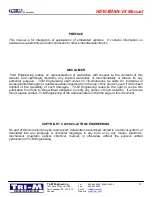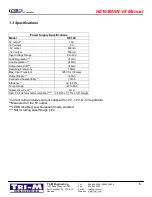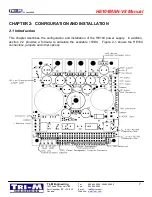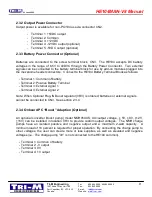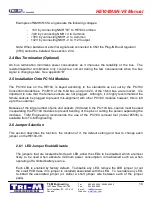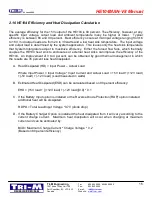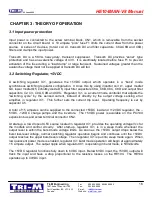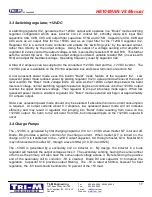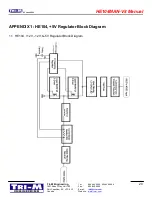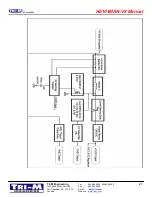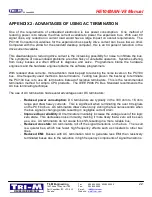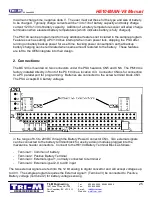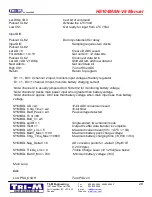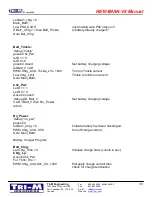
23 June 2005
HE104MAN-V8 Manual
Tri-M Engineering
Tel:
800.665.5600, 604.945.9565
1407 Kebet Way, Unit 100
Fax:
604.945.9566
Port Coquitlam, BC V3C 6L3
E-mail:
Canada
Web site:
www.tri-m.com
17
3.3 Switching regulator, +12VDC
A switching regulator IC2, generates the +12VDC output and operates in a “Boost” mode switching
regulator configuration which uses inductor coil L2, mosfet Q7, schottky diode Q6, input filter
capacitors C9A, C9B, C9C and output filter capacitors C15A and C15B. Capacitors C9A, C9B and
C9C work as an output filter for the +5VDC and as an input filter for the +12VDC regulator IC2.
Regulator IC2 is a current mode controller and adjusts the “switching cycle” by the sensed current,
rather than directly by the output voltage. Using the output of a voltage sensing error amplifier in
regulator IC2 does control the output voltage, which is sensed by resistors R18 and R19. This further
sets the current trip level. If a custom output voltage is ordered, variable resistor R21 (in series with
R19) will adjust the feedback voltage. Operating frequency is set by capacitor C22.
A total of 2 amperes can be supplied to the con12VDC load and the –12VDC invertor. The
+12VDC power is available on the PC/104 expansion bus and screw terminal connector CN2.
A low quiescent power mode uses the built-in “Burst” mode feature of the regulator IC2. Low
quiescent power mode reduces power by placing regulator IC2 in a sleep mode whenever the output
level is within the “Burst” mode voltage limits. As soon as the +12VDC output drops below the burst
low-level voltage, normal switching regulator operation begins and continues until the +12VDC output
reaches the upper burst level voltage. Then regulator IC2 is put into sleep mode again. When low
quiescent power mode is enabled, regulator IC2 “Burst” mode operation will begin at approximately
0.3 ampere output.
Note: Low quiescent power mode should only be selected if absolute minimum current consumption
is required. At output currents about 0.3 amperes, low quiescent power mode will not increase
efficiency and may result in regulator IC2 jumping into “Burst” mode resulting from noise on the
+12VDC output. No harm to IC2 will occur from this, but increased ripple on the +12VDC output will
occur.
3.4 Charge Pumps
The –12VDC is generated by first charging capacitor C13 to +12VDC when mosfet Q7 is turned off.
Diode, D6, provides a path to common for the charge current. When mosfet, Q7, is turned on, the
charge on C13 is transferred to the –12VDC output capacitor, C9, through mosfet, Q10. Mosfet Q10
is synchronized with mosfet, Q7, through a level shifter (C19, D13 and R26)
The –5VDC is generated by a secondary coil on inductor L1. By design, the inductor in a buck
regulator will maintain the output voltage across it. The secondary winding, having the same number
of turns as the primary, will also have the same output voltage across it. By referencing the positive
end of the secondary coil to common, -5V is created. Diode D3 and capacitor C14 improve the
regulation. Capacitor C16 provides output filtering. The –5V is rated at 500mA, however for best
regulation, the –5V load should be limited to 10 percent of the +5V load.

